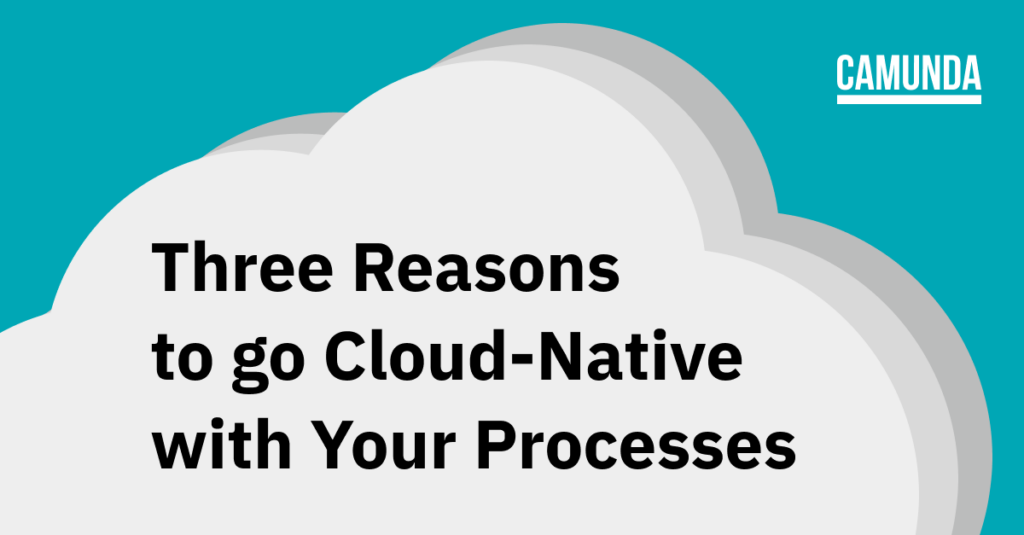Cloud adoption has undergone a dramatic shift in recent years. Five years ago, many organizations were hesitant to embrace cloud and worried about entrusting somebody else with their data. However, as the trust in the high security standards set by cloud providers has grown, more and more companies are investing in cloud-native technology for its many significant benefits.
1. Cloud enables innovation at scale
The ability to scale to an organization’s needs is one of the cloud’s biggest draws and a vital aspect of any cloud-native product. Camunda customers expect and rely on Camunda Platform 8’s ability to orchestrate processes with high throughput at low latency requirements. These organizations are able to bring new products to market fast, which is a significant competitive advantage.
At a time when the hospitality sector was shaken to the core by Covid-19, one of our customers, a leading hospitality company, used Camunda to launch a disruptive, end-to-end digital guest journey and all-encompassing employee solution in just six months, laying the groundwork for significant growth and international expansion. But even organizations that typically see a lower load should consider investing in cloud-native solutions, as failing to do so may result in a weakened ability to innovate and transform.
According to Gartner®, “Today, most people think of the cloud as a technology platform. This perspective will shift markedly by 2027. Cloud computing will not only be a technological approach for delivering applications, but will also serve as the key driver of business innovation.” [1]
In addition to enabling product innovation and agile ways of working for the business, cloud-native solutions themselves benefit from the heightened pace they enable: in the case of Camunda, new product features ship quickest to our SaaS version, enabling users to use new Connectors or new features for Web Modeler as soon as they are released.
2. Cloud technology is reliable, resilient and safe
As well as product features being available more quickly, SaaS customers benefit from the same speed of delivery when it comes to security patches. At Camunda, they don’t have to do so much as lift a finger, as we deploy patches to all clusters straight away.
In addition to immediately rolling out patches, strict security standards have been introduced to ensure information security, for example with regards to customer data. Camunda is ISO 27001 as well as SOC 2 certified, and ISO 27017/18 is on our roadmap.
Cloud-native architectures also make for more resilient and higher performing solutions: distributed systems (where data is distributed across all brokers in a cluster) and pre-configured replication mechanisms like in Zeebe allow for a quick recovery from potential outages without the need for human intervention. In addition, they eliminate risks such as data loss and significant downtime. Our recent minor release further improves resilience and performance by enabling more flexibility when choosing regions for Zeebe clusters.
These benefits can be shared across the organization for improved governance. Cloud solutions enable Centers of Excellence and IT admin to gain a better overview of all processes running organizationwide, making it easier to share best practices internally.
3. Cloud sets organizations up for the future
Should these considerations not be relevant for your organization, ensuring you keep your competitive edge might be the one driver that changes that. As Gartner puts it:
“In 2027, cloud will be the pervasive style of computing. New workloads deployed outside of a cloud-native environment will be rare, and anything noncloud will be considered legacy.”
ー Gartner Research: The Future of Cloud Computing in 2027: From Technology to Business Innovation, October 2022
In other words: you will be left behind if you do not embrace Cloud sooner rather than later. Trends in spending show that more and more organizations have realized this and are increasing investment in SaaS solutions: Gartner expects that “by 2026, public cloud spending will exceed 45% of all enterprise IT spending, up from less than 17% in 2021.” This prognosis reflects one of the findings of Camunda’s 2023 State of Process Orchestration report, where 97% of respondents expressed plans to invest in technologies that are scalable and enable guaranteed availability for high-throughput workloads.
The time is now
Cloud-native technology offers scalability, reliability, resilience and more. By investing strategically now, even if the need for scale, speed or high throughput is not pressing, you are future-proofing your business and ensuring you can adapt and innovate as and when the opportunity arises. Many of our customers are already embracing Camunda Platform 8. Some are going all in by migrating their existing processes, while others are building new processes in Camunda 8 to get acquainted with it before embarking on their migration journey.
If you have any questions on what the best approach is for your organization, please do not hesitate to reach out to us.
Learn more at CamundaCon 2023
Join us at CamundaCon 2023 to find out how organizations like Cisco leverage Camunda’s cloud-native platform to drive their digital transformation projects. Tickets are available now. Click here to register.
[1] Gartner Research: The Future of Cloud Computing in 2027: From Technology to Business Innovation, October 2022. GARTNER is a registered trademark and service mark of Gartner, Inc. and/or its affiliates in the U.S. and internationally and is used herein with permission. All rights reserved

